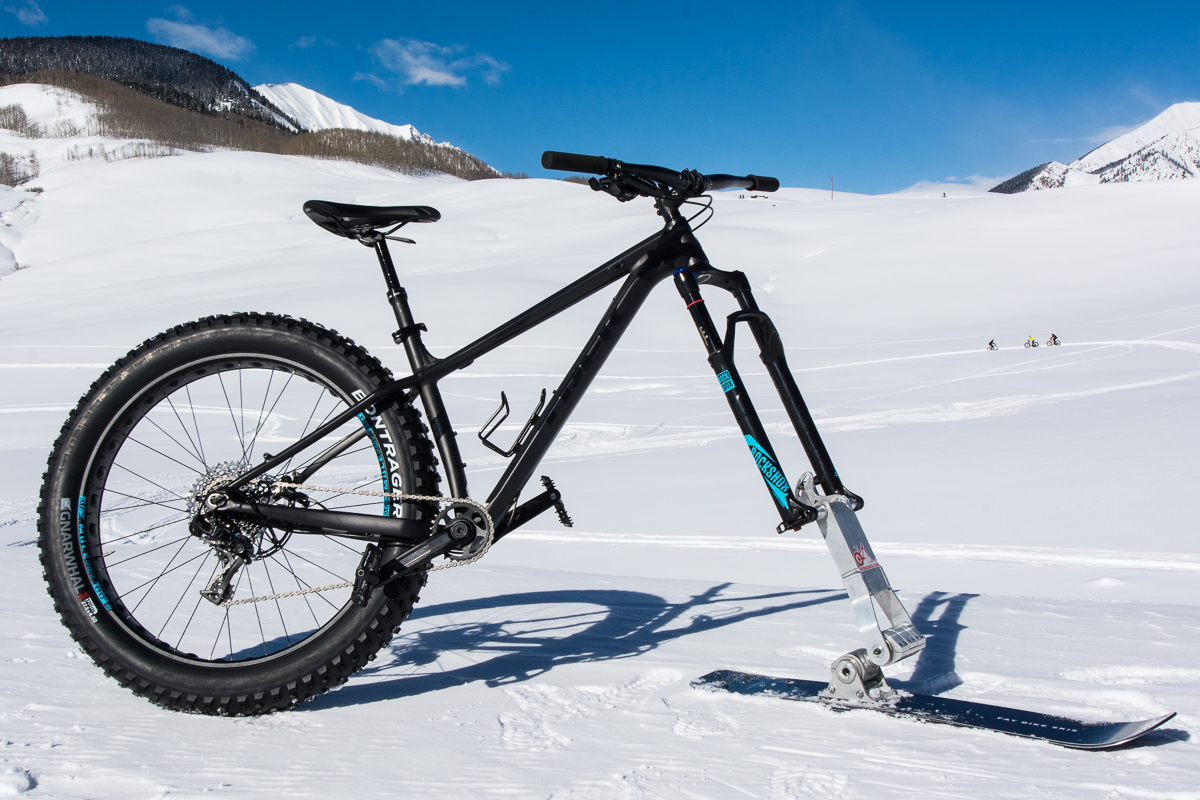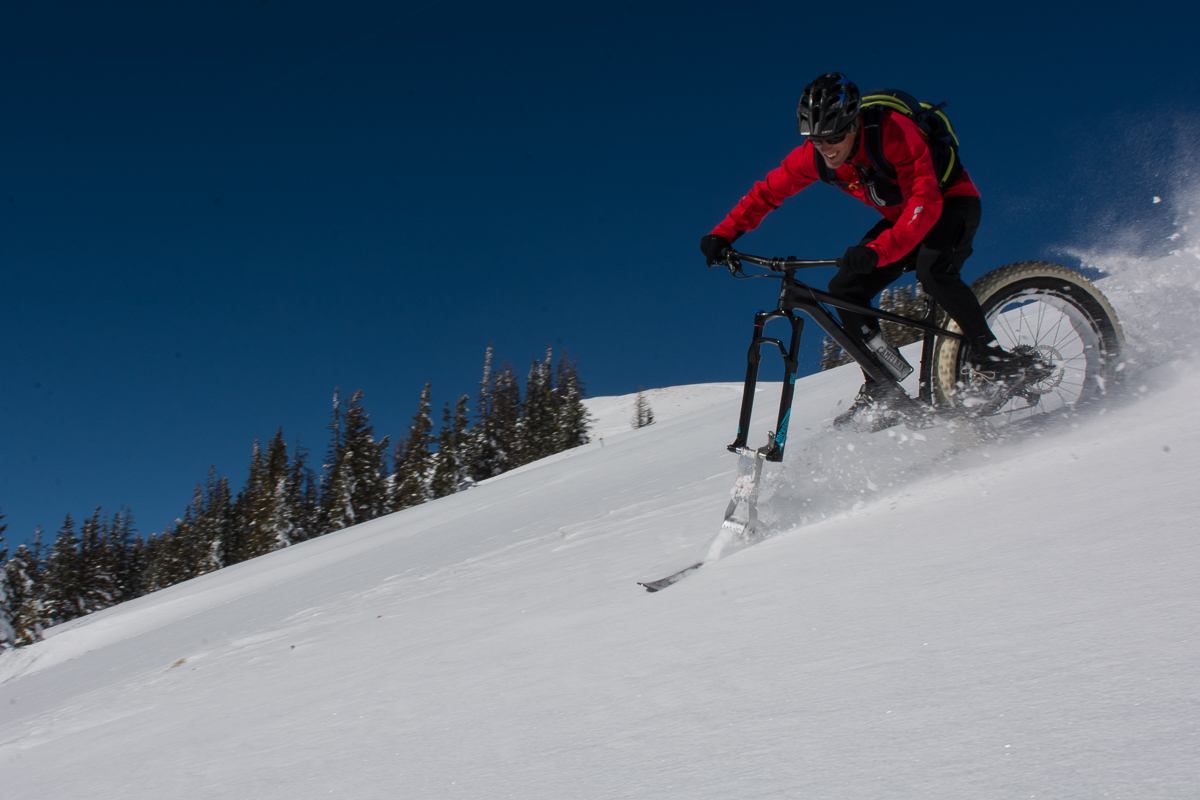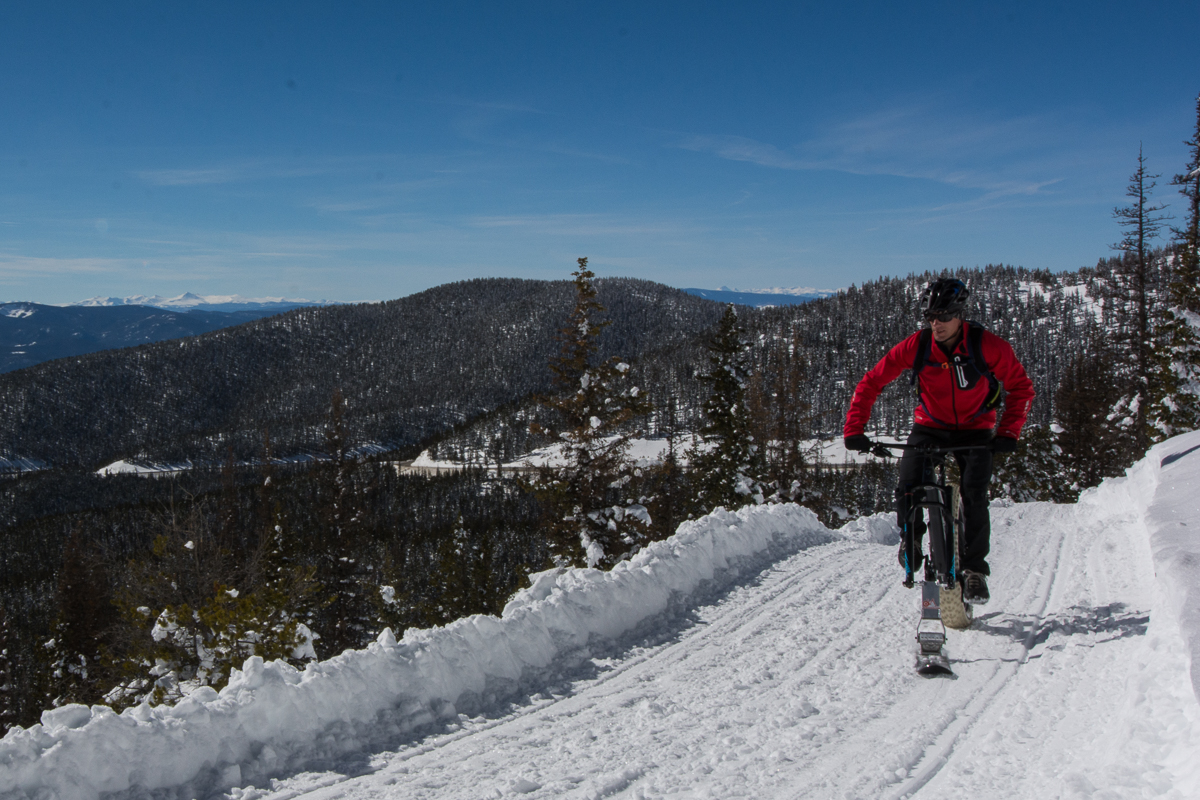Review: Fat Bike Ski
Originally posted on March 1, 2017 at 1:00 amWords and photos by Zach White
Ask anyone who’s ridden a fat bike in snow, and if they’re the honest type, they’ll tell you how finicky the bikes are about conditions. Specifically, if the snow isn’t hardpacked, riding will be difficult, if not impossible. On soft, ungroomed trail, front tires don’t offer much float or bite for steering, and even 5-inch-wide rear tires have a tendency to lose traction, unless rider weight is perfectly positioned in the magic spot. Even then, it may be all for not as the front wheel slides out due to the position shift needed to keep traction. Self-propelled sections on flats or climbs can quickly motivate one to u-turn back down to the trailhead, and descents in these less-than-ideal conditions usually end in a lost game of chance that results in more time sprawled in the snow than on the bike. Sure, this kind of sketchiness can be the charm of fat bikes for some, and pushing through such slow, vague and unstable conditions is what puts a smile on their face. But, for many, this lack of control results in a lack of enjoyment or interest in riding in the snow.

Enter the Fat Bike Ski. Designed to replace the front wheel and front brake on basically any fat bike with a suspension fork, the 100cm/39.4in long and 16cm/6.3in wide ski not only provides two metal edges to dig into the snow for steering, but also adds a comparatively huge contact patch for float. While it’s hard to compare a round and variantly-inflated tire to a flat and hard surface, lazy science can compare a 5in wide tire at anywhere between 5in and 10in long for a liberal range of 25-to-50 square inches of surface area, verses 248.2 square inches for the ski.



A rather chunky alloy mount holds the Fat Bike Ski on to the fork by a standard 15mm thru axle, and a bracket bolts to the front brake mounts to keep it from rotating around the axle. Between this fork mount and the ski is a dual pivot urethane torsion spring, which allows the ski to smoothly follow trail pitch without being too flimsy—think of it as an artificial ankle on a skier. If you know your obscure mountain bike suspension history, this type of torsional spring may ring a bell as it was used experimentally in the late 90’s and early 2000’s as a replacement to standard rear shocks. Frame companies like GSR used a cylindrical, elastomer-type urethane with a profile akin to a modern bottom bracket spindle, which keyed into a complimenting alloy shell built into the frame and rocker. The Fat Bike Ski’s design specifics are still under wraps, but best guess is that it’s a similar design inside the alloy clamps seen in the photos. The good thing about this kind of application is that it typically saves weight over more traditional shocks, allows for a much cleaner and more streamlined design than one in need of standard shock stoke paths, and should be very low maintenance. The potential issue would be lack of damping adjustment, but with an application like this, that’s a longshot of a concern.


Out on the trai … errr, snow, the Fat Bike Ski is an entirely different beast than a fat bike with a 5-inch-tired front wheel. Once past the initial learning curve of finding and using the ski’s edges in turns, and realizing that having an edge in the snow is much more suitable than the front brake that you’re freaking out about omitting, it doesn’t take long to blast through powdery, soft and chunky trail that otherwise would be impossible to ride on a regular fat bike. Climbing still requires packed snow in order to maintain rear wheel traction, but having the extra surface area up front drastically softens the need to find that otherwise tiny balancing point between pedaling forward and not having the front end wash out. I found myself sliding up to the very tip of the saddle’s nose in some instances, and even climbing out of the saddle on a few occasions. Switching back and forth between a bike with a ski and one without, there was a noticeable difference in how well the Fat-Bike-Ski-equipped bike climbed due to the added stability.

Descending on the Fat Bike Ski in snow is something that undeniably puts it in its own category of winter riding. On a rare lift-accessed fat bike day at Crested Butte for FBW weekend, the mountain’s attempt at fat bike singletrack was a bit of a miss as the trail quickly churned and chunked into an all-but-unridable slip-n-slide. It was so unridable that the mountain decided to close it, but even after the trail had been blown out, I was able to comfortably ride the soft, chunky and powdery conditions on a bike with a Fat Bike Ski. It was even possible to get a few pedal strokes in to pick up speed, but generally speaking, descending through this kind of snow was more of a coasting/skiing experience.

There wasn’t a need or chance to install one, but the Fat Bike Ski appears to be pretty straightforward in that it just requires removing the front brake and wheel, and using the fork’s brake mount and thru-axle to mount the Ski. There aren’t any adjustments or tunes, other than the adjustment in riding style, so once it’s attached, it’s ready to ride. And when the snow melts, reversing the simple process should get a bike ready for mixed trail conditions within minutes.
Obviously, the Fat Bike Ski is designed to only work in snow, and not every fat bike out there is ridden in pure snow. But for those who do ride in full coverage conditions, the Ski is something worth checking out.
For those interested in fat bike races, FBW allowed it in their 18-mile XC race, but it sounds like promotors of downhill snow bike races are creating separate classes for Fat Bike Ski equipped bikes, or not letting them race if there aren’t enough people to create a separate category.

The Fat Bike Ski will be available sometime next fall. More info at www.fatbikeskis.com.
MSRP: $875 (or $799 pre-order with a $400 deposit)